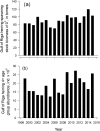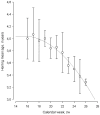Thermal conditions and age structure determine the spawning regularities and condition of Baltic herring (Clupea harengus membras) in the NE of the Baltic Sea
- PMID: 31367488
- PMCID: PMC6657675
- DOI: 10.7717/peerj.7345
Thermal conditions and age structure determine the spawning regularities and condition of Baltic herring (Clupea harengus membras) in the NE of the Baltic Sea
Abstract
Baltic herring (Clupea harengus membras) is a total spawner with a group-synchronous ovarian organization. Age polymodality in total spawners is considered an important factor in assuring that a strong population is sustainable under an intensive harvesting regime and different climatic conditions. In the present study, we investigated the seasonal and inter-annual variation in spawner age structure and the effect of preceding winter thermal conditions on the start of the herring spawning and larvae retention period. Herring spawning season in the Gulf of Riga starts up to six weeks later after colder winters compared to milder winters. Significantly older individuals dominated at the beginning of the spawning season, and thus herring mean age gradually decreased towards the end of the spawning season from 1999-2015. On an annual scale, this pattern was obvious after cold winters, while after mild winters the pattern did not continue, indicating a more homogenous maturation cycle and spawning period, despite the age and size of the herring population in mild winters. Further, herring condition factor was studied in relation to age and spawning season following different winter thermal conditions. Young, 2- and 3- year old first-spawning herring experienced significantly lower conditions after cold winters compared to older ages, indicating an age-dependent effect of preceding winter on herring maturation cycle, condition and spawning time.
Keywords: Age structure; Baltic herring; Condition factor; Preceding winter; Spawning time.
Conflict of interest statement
The authors declare there are no competing interests.
Figures







Similar articles
-
Early arrival of spring-spawning Atlantic herring Clupea harengus at their spawning ground in the Kiel Fjord, western Baltic, relates to increasing winter seawater temperature.J Fish Biol. 2024 Sep;105(3):766-778. doi: 10.1111/jfb.15811. Epub 2024 Jun 10. J Fish Biol. 2024. PMID: 38859548
-
A productivity bottleneck in the Baltic herring (Clupea harengus membras): Early life-history processes and recruitment variability.Mar Environ Res. 2022 May;177:105638. doi: 10.1016/j.marenvres.2022.105638. Epub 2022 May 3. Mar Environ Res. 2022. PMID: 35533438
-
Disentangling seasonal from maternal effects on egg characteristics in western Baltic spring-spawning herring Clupea harengus.J Fish Biol. 2022 Dec;101(6):1428-1440. doi: 10.1111/jfb.15210. Epub 2022 Sep 28. J Fish Biol. 2022. PMID: 36065986
-
Metazoan parasites from herring (Clupea harengus L.) as biological indicators in the Baltic Sea.Acta Parasitol. 2014 Sep;59(3):518-28. doi: 10.2478/s11686-014-0276-5. Epub 2014 Aug 15. Acta Parasitol. 2014. PMID: 25119368
-
Broad-scale climate influences on spring-spawning herring (Clupea harengus, L.) recruitment in the Western Baltic Sea.PLoS One. 2014 Feb 25;9(2):e87525. doi: 10.1371/journal.pone.0087525. eCollection 2014. PLoS One. 2014. PMID: 24586279 Free PMC article.
Cited by
-
The Laboratory Domestication of Zebrafish: From Diverse Populations to Inbred Substrains.Mol Biol Evol. 2020 Apr 1;37(4):1056-1069. doi: 10.1093/molbev/msz289. Mol Biol Evol. 2020. PMID: 31808937 Free PMC article.
-
Effects of zooplankton abundance on the spawning phenology of winter-spawning Downs herring (Clupea harengus).PLoS One. 2025 Feb 5;20(2):e0310388. doi: 10.1371/journal.pone.0310388. eCollection 2025. PLoS One. 2025. PMID: 39908261 Free PMC article.
-
Diversity and dynamics of fish ovaries: Insights into reproductive strategies, hormonal regulation, and ovarian development.Histol Histopathol. 2025 Mar;40(3):283-295. doi: 10.14670/HH-18-802. Epub 2024 Jul 31. Histol Histopathol. 2025. PMID: 39311399 Review.
References
-
- Anderson DA, Scharf FS. The effect of variable winter severity on size-dependent overwinter mortality caused by acute thermal stress in juvenile red drum (Sciaenops ocellatus) ICES Journal of Marine Science. 2013;71(4):1010–1021. doi: 10.1093/icesjms/fst041. - DOI
-
- Arula T, Kotta J, Lankov A, Simm M, Põlme S. Diet composition and feeding activity of larval spring-spawning herring: importance of environmental variability. Journal of Sea Research. 2012;68:33–40. doi: 10.1016/j.seares.2011.12.003. - DOI
-
- Arula T, Laur K, Simm M, Ojaveer H. Dual impact of temperature on growth and mortality of marine fish larvae in a shallow estuarine habitat. Estuarine, Coastal and Shelf Science. 2015;167:326–335. doi: 10.1016/j.ecss.2015.10.004. - DOI
LinkOut - more resources
Full Text Sources

